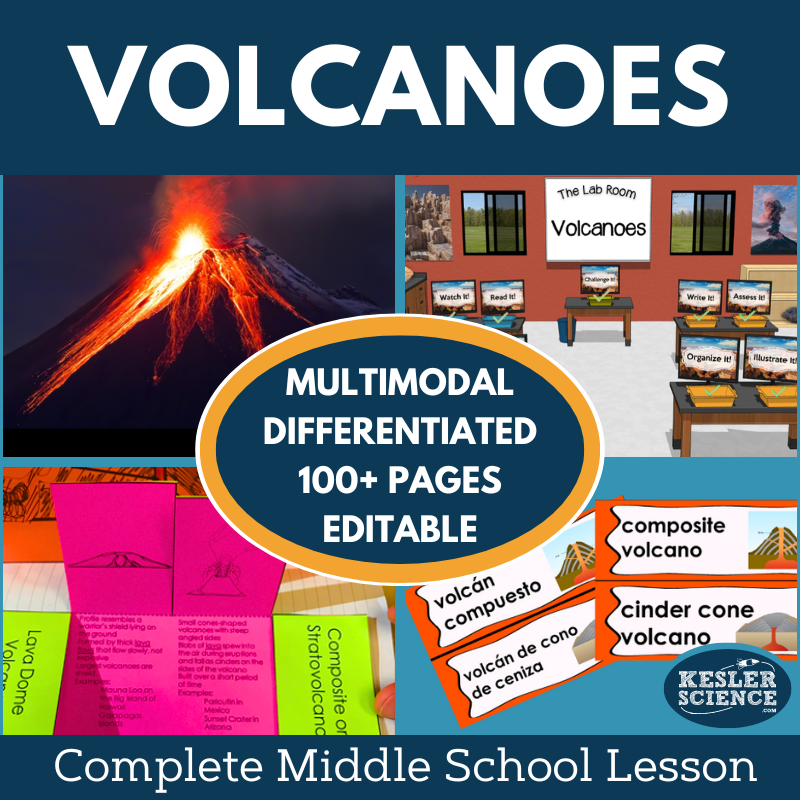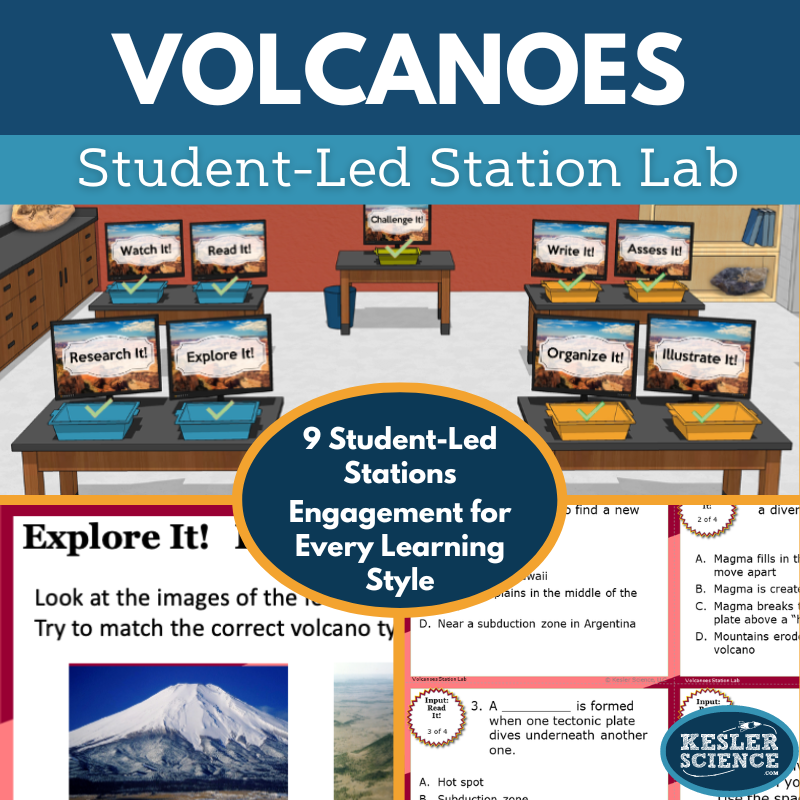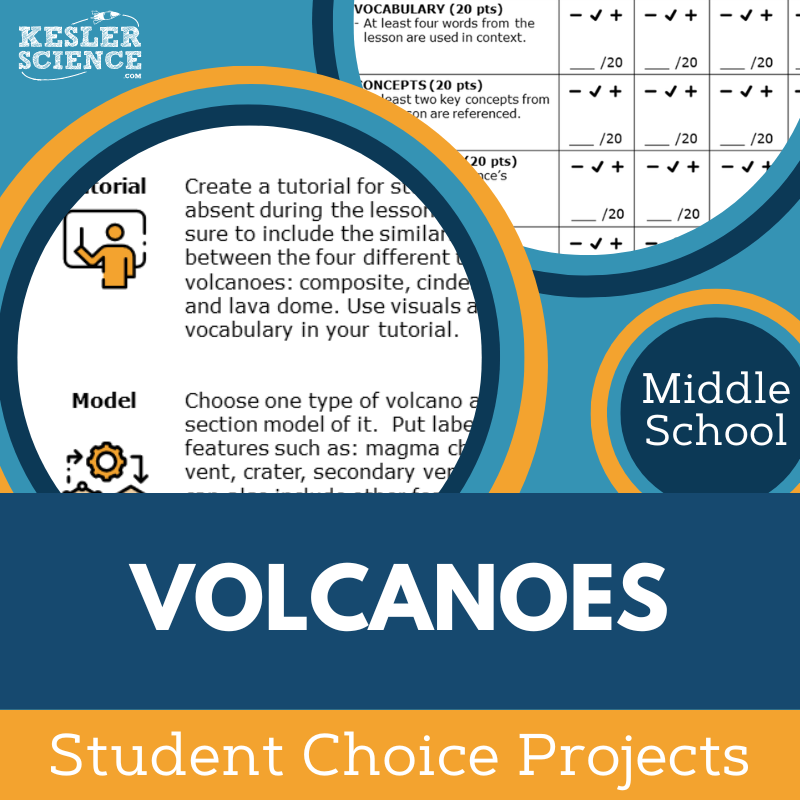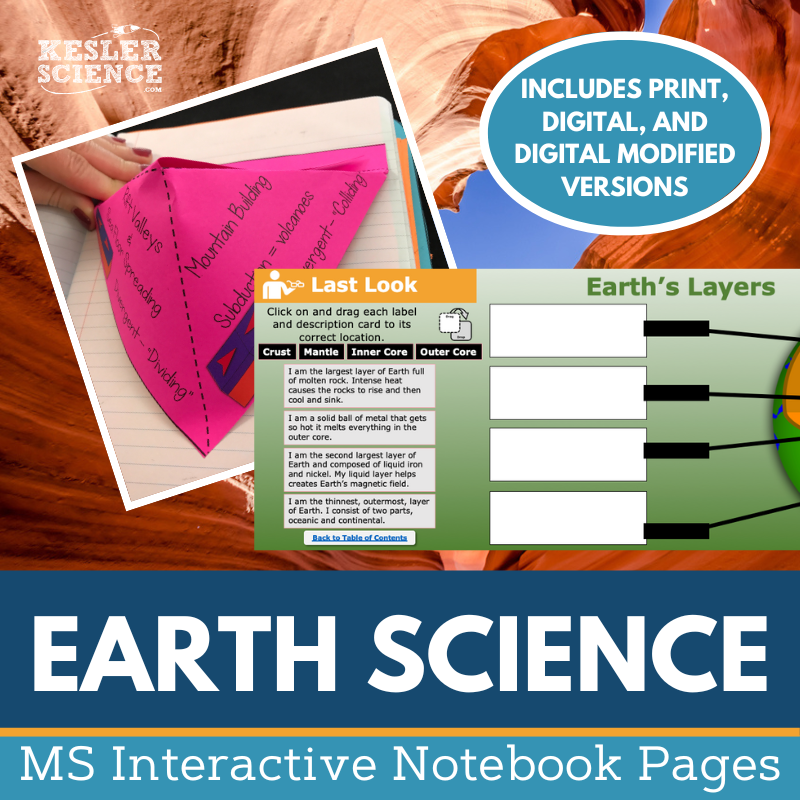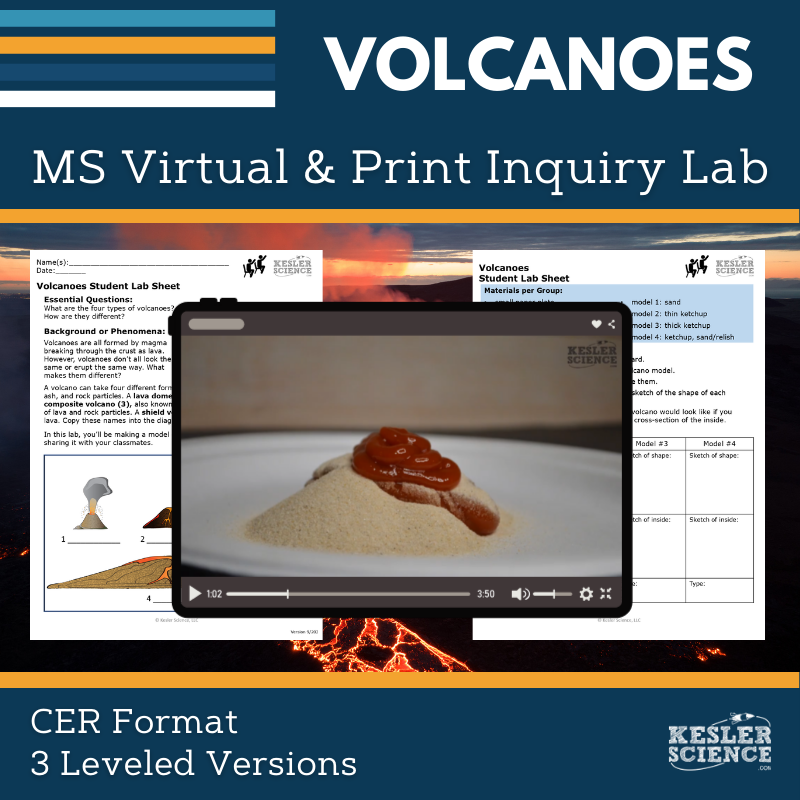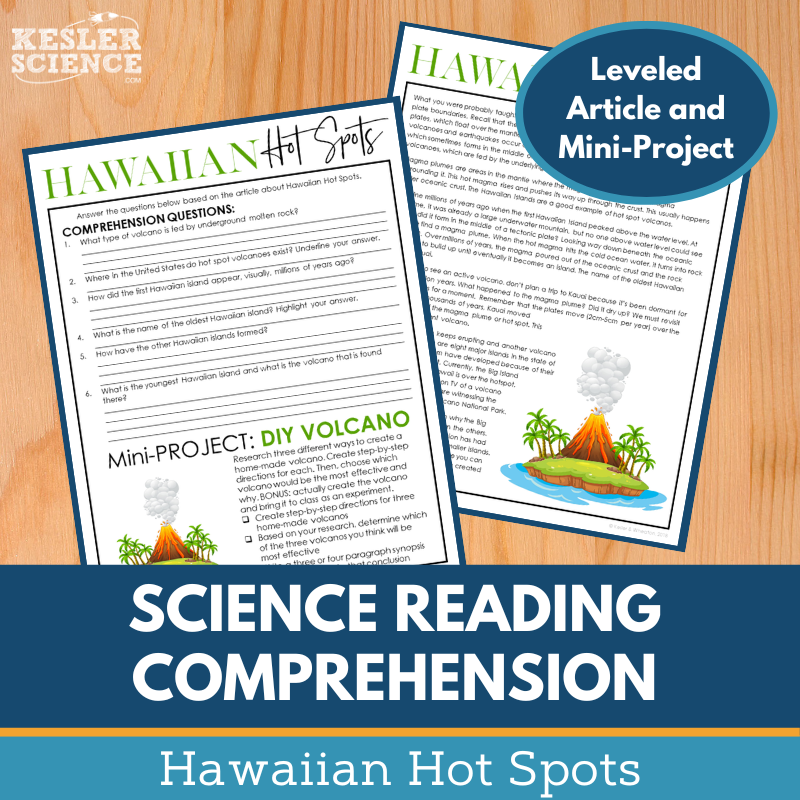Volcanoes Activities for Middle School Science
The Kesler Science Volcanoes resources provide middle school students with hands-on, multimodal learning experiences to explore volcano types, structures, and processes. The resources below will give students a comprehensive understanding of volcanoes. All of the following materials are also included in the Kesler Science Membership.
The Kesler Science Volcanoes Complete 5E Lesson offers everything you need for an engaging, multi-day exploration of volcanoes for grades 6–8. Using the 5E Model, this comprehensive resource answers essential questions such as “What are the parts of a volcano?” and “What processes form volcanoes?” With differentiated materials, multimodal learning, and flexible formats, students of all levels can dive into earth science concepts.
The Exploration phase features a nine-station lab where students investigate volcanoes through hands-on experiments, readings, videos, and digital research. Output stations like “Organize It!” and “Illustrate It!” allow students to demonstrate understanding, while “Challenge It!” offers advanced activities for early finishers. Editable PowerPoints, Spanish translations, and interactive notebook templates in multiple formats support customization and accessibility.
This resource is designed for both in-class and virtual learning environments, with digital options available for remote students. Assessments, review questions, and student-choice projects provide comprehensive evaluation opportunities, making this lesson adaptable for diverse classrooms while fostering student engagement and success.
The Kesler Science Volcanoes Complete 5E Lesson offers everything you need for an engaging, multi-day exploration of volcanoes for grades 6–8. Using the 5E Model, this comprehensive resource answers essential questions such as “What are the parts of a volcano?” and “What processes form volcanoes?” With differentiated materials, multimodal learning, and flexible formats, students of all levels can dive into earth science concepts.
The Exploration phase features a nine-station lab where students investigate volcanoes through hands-on experiments, readings, videos, and digital research. Output stations like “Organize It!” and “Illustrate It!” allow students to demonstrate understanding, while “Challenge It!” offers advanced activities for early finishers. Editable PowerPoints, Spanish translations, and interactive notebook templates in multiple formats support customization and accessibility.
This resource is designed for both in-class and virtual learning environments, with digital options available for remote students. Assessments, review questions, and student-choice projects provide comprehensive evaluation opportunities, making this lesson adaptable for diverse classrooms while fostering student engagement and success.
The Kesler Science Volcanoes Station Lab immerses middle school students in the study of how geoscience processes shape Earth's surface. This student-led, modular activity offers eight differentiated stations and a bonus challenge station, allowing students to direct their learning while teachers facilitate the experience. The lab’s comprehensive materials reduce prep time and promote engagement through hands-on, research, and multimedia activities.
The nine stations include input stations like “Explore It!” for hands-on demonstrations, “Read It!” for reading comprehension, and “Watch It!” for video-based learning. Output stations such as “Organize It!” and “Illustrate It!” encourage students to apply and communicate their understanding, while “Write It!” and “Assess It!” provide structured opportunities for reflection and assessment. A challenge station provides advanced learners with engaging extension activities.
Designed for flexibility, the Volcanoes Station Lab is ideal for both in-class and virtual learning environments, with digital versions available for remote students. The differentiated activities, Spanish-language options, and multimodal approach ensure accessibility and personalization, fostering deeper understanding of earth science concepts.
The Kesler Science Volcanoes Station Lab immerses middle school students in the study of how geoscience processes shape Earth's surface. This student-led, modular activity offers eight differentiated stations and a bonus challenge station, allowing students to direct their learning while teachers facilitate the experience. The lab’s comprehensive materials reduce prep time and promote engagement through hands-on, research, and multimedia activities.
The nine stations include input stations like “Explore It!” for hands-on demonstrations, “Read It!” for reading comprehension, and “Watch It!” for video-based learning. Output stations such as “Organize It!” and “Illustrate It!” encourage students to apply and communicate their understanding, while “Write It!” and “Assess It!” provide structured opportunities for reflection and assessment. A challenge station provides advanced learners with engaging extension activities.
Designed for flexibility, the Volcanoes Station Lab is ideal for both in-class and virtual learning environments, with digital versions available for remote students. The differentiated activities, Spanish-language options, and multimodal approach ensure accessibility and personalization, fostering deeper understanding of earth science concepts.
The Kesler Science Volcanoes Student Choice Projects offer middle school students the opportunity to select a project that suits their learning and output style. With six structured project options and a “design your own” choice, this activity promotes creativity and personalized learning. A grading rubric supports assessments by teachers, peers, or students themselves, making this resource versatile for classroom use.
This flexible, differentiated resource includes editable rubric pages and teacher directions to accommodate a variety of learning needs. The modified project page provides options for students requiring additional support, while advanced learners can tackle a combination of projects for a greater challenge. These multimodal activities encourage students to demonstrate their understanding of volcanoes in creative ways.
The projects use common classroom supplies such as paper, markers, and scissors, with many activities adaptable for digital formats. Optional crafting supplies allow students to build models, enhancing hands-on engagement. This resource combines differentiation, creativity, and ease of implementation to enrich Earth science lessons.
The Kesler Science Volcanoes Student Choice Projects offer middle school students the opportunity to select a project that suits their learning and output style. With six structured project options and a “design your own” choice, this activity promotes creativity and personalized learning. A grading rubric supports assessments by teachers, peers, or students themselves, making this resource versatile for classroom use.
This flexible, differentiated resource includes editable rubric pages and teacher directions to accommodate a variety of learning needs. The modified project page provides options for students requiring additional support, while advanced learners can tackle a combination of projects for a greater challenge. These multimodal activities encourage students to demonstrate their understanding of volcanoes in creative ways.
The projects use common classroom supplies such as paper, markers, and scissors, with many activities adaptable for digital formats. Optional crafting supplies allow students to build models, enhancing hands-on engagement. This resource combines differentiation, creativity, and ease of implementation to enrich earth science lessons.
The Kesler Science Earth Science Interactive Notebook Bundle is a must-have for teachers who want to provide an interactive learning experience in earth science. It includes both print and digital versions, making it a versatile resource for traditional classrooms, 1:1 environments, and distance learning.
The bundle covers a wide range of earth science topics, including continental drift theory, plate boundaries, rocks and minerals, the rock cycle, Earth’s layers, volcanoes, earthquakes, and more. It also features activities like Venn diagrams, topographic maps, and reflection pages to help students demonstrate understanding and make connections between concepts.
The digital version includes a unique interactive notebook PowerPoint, which can be uploaded to Google Slides or learning management systems like MS Teams and Canvas. The paper version provides blank and pre-filled templates, along with color photos to guide students in completing each activity. Both versions come with a teacher answer key and a modified version for students with accommodations.
The Kesler Science Earth Science Interactive Notebook Bundle is a must-have for teachers who want to provide an interactive learning experience in earth science. It includes both print and digital versions, making it a versatile resource for traditional classrooms, 1:1 environments, and distance learning.
The bundle covers a wide range of earth science topics, including continental drift theory, plate boundaries, rocks and minerals, the rock cycle, Earth’s layers, volcanoes, earthquakes, and more. It also features activities like Venn diagrams, topographic maps, and reflection pages to help students demonstrate understanding and make connections between concepts.
The digital version includes a unique interactive notebook PowerPoint, which can be uploaded to Google Slides or learning management systems like MS Teams and Canvas. The paper version provides blank and pre-filled templates, along with color photos to guide students in completing each activity. Both versions come with a teacher answer key and a modified version for students with accommodations.
The Volcano Inquiry Lab helps students understand the four types of volcanoes by building and analyzing physical models. Each group creates one model using materials like sand or various ketchup mixtures, then participates in a gallery walk to observe and compare different types. As they interact with each model, students sketch the volcanoes and label their parts, reinforcing key structural features.
Both digital and print formats are included to offer flexible, engaging experiences in any classroom setting. Comprehension questions, C.E.R. prompts, and reflection sections are integrated into each version. Differentiation is built in with three tiers—Modified, Dependent, and Independent—designed to support learners of all abilities, from those who need structured guidance to those ready for open-ended inquiry.
No materials are required for the virtual version, making it ideal for absent students or low-supply classrooms. The labs are fully editable and compatible with Google Slides and common learning management systems. Teacher resource pages, answer keys, and editable components make planning and implementation easy and efficient.
The Volcano Inquiry Lab helps students understand the four types of volcanoes by building and analyzing physical models. Each group creates one model using materials like sand or various ketchup mixtures, then participates in a gallery walk to observe and compare different types. As they interact with each model, students sketch the volcanoes and label their parts, reinforcing key structural features.
Both digital and print formats are included to offer flexible, engaging experiences in any classroom setting. Comprehension questions, C.E.R. prompts, and reflection sections are integrated into each version. Differentiation is built in with three tiers—Modified, Dependent, and Independent—designed to support learners of all abilities, from those who need structured guidance to those ready for open-ended inquiry.
No materials are required for the virtual version, making it ideal for absent students or low-supply classrooms. The labs are fully editable and compatible with Google Slides and common learning management systems. Teacher resource pages, answer keys, and editable components make planning and implementation easy and efficient.
This engaging reading comprehension activity allows middle school students to explore hot-spot volcanoes through a nonfiction article about the Hawaiian Islands. Students enhance science literacy by completing comprehension questions, designing instructions for creating three volcano models, and writing a brief synopsis. The resource is designed to improve critical thinking and reading comprehension through annotating, highlighting, and responding to leveled passages.
The activity includes two Lexile-leveled articles (1100-1300) with corresponding questions, a hands-on mini-project, and detailed student directions. Additional tools like Cornell notes templates and printable graphics are provided for flexible use in class or remote learning environments. Digital resources include Google Forms answer sheets, modified reading passages, and tutorials for distance learning.
This versatile resource is ideal for absent students, extra credit, sub plans, or whole-class instruction. Teachers can use it to foster science literacy throughout a unit or spark engaging classroom discussions. Designed to build textual analysis skills, this activity supports students in connecting science content with critical reading practices.
This engaging reading comprehension activity allows middle school students to explore hot-spot volcanoes through a nonfiction article about the Hawaiian Islands. Students enhance science literacy by completing comprehension questions, designing instructions for creating three volcano models, and writing a brief synopsis. The resource is designed to improve critical thinking and reading comprehension through annotating, highlighting, and responding to leveled passages.
The activity includes two Lexile-leveled articles (1100-1300) with corresponding questions, a hands-on mini-project, and detailed student directions. Additional tools like Cornell notes templates and printable graphics are provided for flexible use in class or remote learning environments. Digital resources include Google Forms answer sheets, modified reading passages, and tutorials for distance learning.
This versatile resource is ideal for absent students, extra credit, sub plans, or whole-class instruction. Teachers can use it to foster science literacy throughout a unit or spark engaging classroom discussions. Designed to build textual analysis skills, this activity supports students in connecting science content with critical reading practices.
Year-Round Resources
These year-round activities will increase your students' understanding of many middle school science topics. All of these activities are also included in the Kesler Science Membership.
Visual Data & Graphing
You're not alone if your students struggle with understanding graphs, charts, and tables. It's a skill that takes an enormous amount of practice. This resource will help students build a strong foundation in analyzing data and creating their own data visualizations.
Bell Ringers and Warm-Ups
These middle school science bell ringers are an excellent way to engage your students as soon as they walk into your classroom. This comprehensive FULL YEAR resource includes everything you need to start off each science class with an interesting warm-up activity.
Review Board Games
Each game board has been carefully designed to keep students engaged. There are 10 different action spaces on each board and dozens of question cards. All of the actions are related to science concepts and keep the students motivated throughout the game.
Each game is ready to play. Simply print out the board and the cards and let the students enjoy reviewing nine different units.
Essential Questions
Below are the essential questions associated with the lessons and activities included in this unit. This topic is only one of more than 100 middle school science topics included in the Kesler Science Membership.
-
What are the parts of a volcano?
-
What are the four types?
-
What processes form volcanoes?
-
Where are volcanoes located on Earth?
Kesler Science Membership
Imagine never having to search for another middle school science lesson again. The membership gives you access to ALL of the Kesler Science products in one place (Yes, including everything above).
Say goodbye to long hours of lesson prep.

